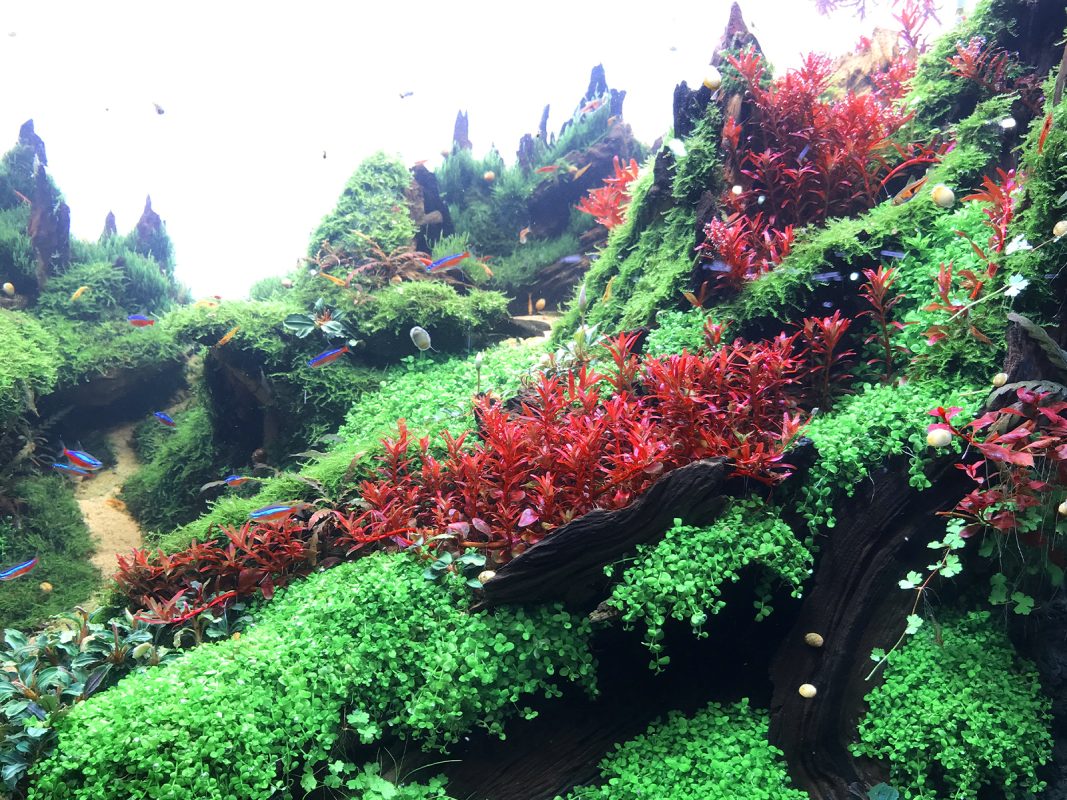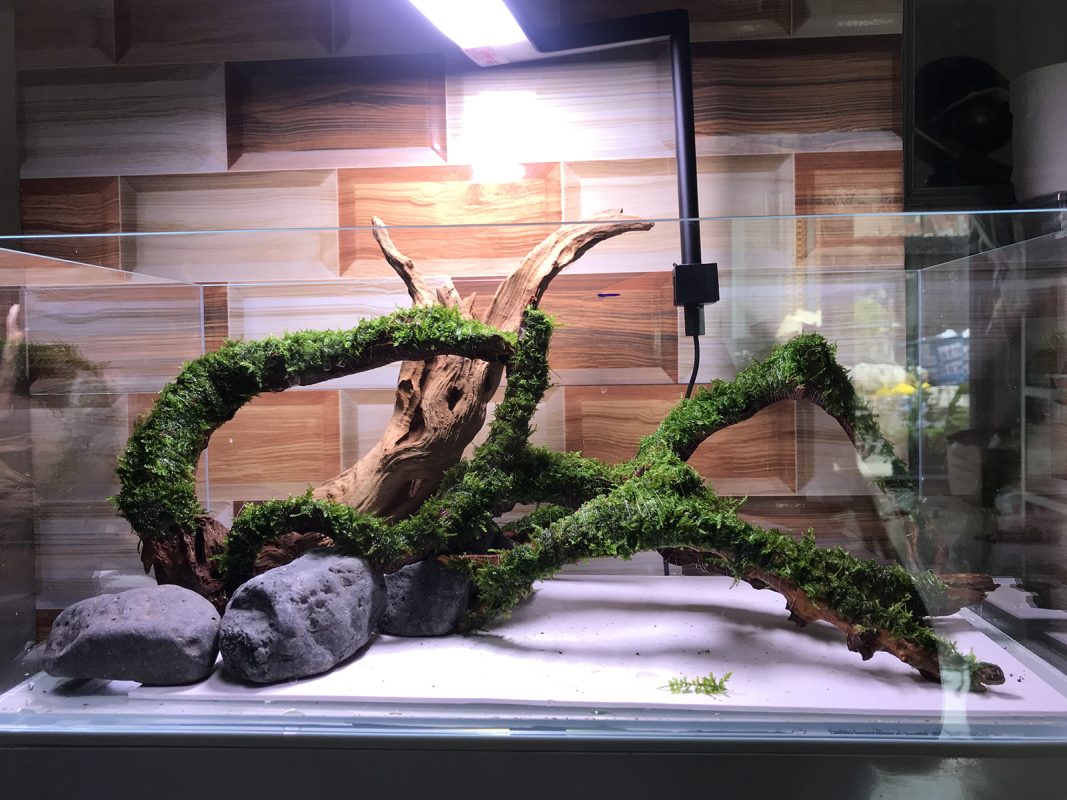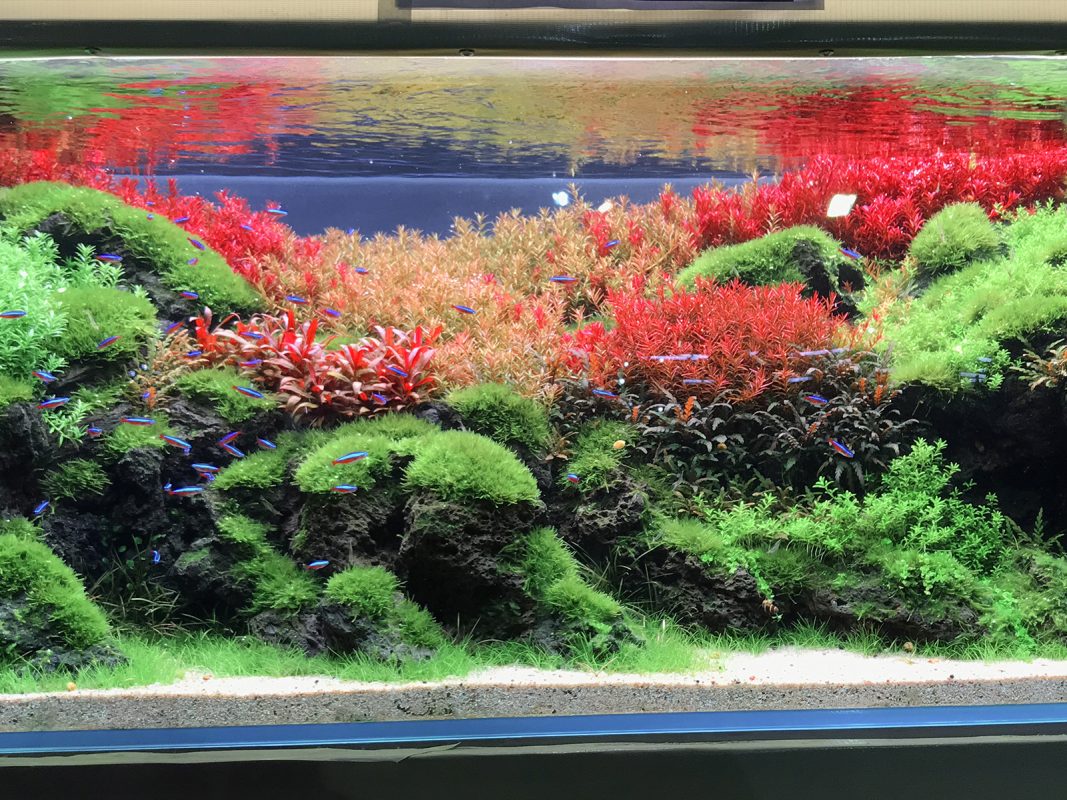Blogs
A Comprehensive Guide to Aquascaping with Aquatic Plants
Aquascaping is the creation and arrangement of aquatic plants, rocks, stones, driftwood, and other aquarium elements to create aesthetically pleasing underwater landscapes. It’s akin to painting, where the aquarium is the canvas and the plants, rocks, and woods are the colors and brushes. This hobby has surged in popularity due to its artistic and meditative qualities, blending creativity with aquatic science.
The Art and Science of Aquascaping
Aquascaping is both an art and a science. It involves the meticulous placement of plants, rocks, and other materials to achieve a visually appealing composition. Techniques like the rule of thirds, depth, and perspective are commonly employed, similar to photography or fine art. The Dutch style, for example, uses densely planted rows of vibrant plants, creating a mesmerizing aquatic garden. On the scientific side, aquascapers need a profound understanding of aquatic biology, water chemistry, and plant physiology. This includes managing light, CO2 levels, and water parameters to ensure the aquatic flora and fauna thrive. For instance, plants like Dwarf Baby Tears require high light and CO2, making them demanding yet incredibly rewarding to grow.
Benefits of Aquascaping
Aquascaping offers numerous benefits, both aesthetically and scientifically. Visually, it transforms a plain tank into an enchanting underwater Eden, becoming a stunning focal point. Functionally, it improves water quality as plants absorb excess nutrients and oxygenate the water. This creates a natural filtration system that benefits fish and invertebrates. Additionally, aquascaping provides stress-relieving hideouts for fish, reducing aggressive behavior and improving their well-being. Engaging in aquascaping can also be therapeutic for the human mind, fostering a connection with nature and offering a peaceful, hands-on hobby.
Types of Aquascaping Styles
Aquascaping styles are diverse and offer endless creative possibilities:
- Nature Aquarium Style: Inspired by nature, it replicates the look of streams, rivers, or lakes.
- Iwagumi Style: Minimalist, focused on rock placements adhering to Japanese garden design principles.
- Dutch Style: Characterized by dense plantings in rows, using varied colors and leaf shapes.
- Jungle Style: Emulates a wild, overgrown rainforest with tall, fast-growing plants.
- Biotope Style: Recreates specific natural habitats, including appropriate plants, substrates, and hardscape materials to reflect ecosystems like the Amazon River or African lakes.
Planning Your Aquascape

Choosing Your Aquarium
Selecting the right aquarium is the foundation of a successful aquascape. Factors such as tank size, material, and shape play critical roles. Larger tanks provide more space for creative layouts and stability in water parameters, making them suitable for intricate designs. Conversely, smaller tanks are more manageable but can be challenging due to limited space. When choosing the material, glass tanks are clear and scratch-resistant, whereas acrylic tanks are lighter and more impact-resistant.
Defining Your Aquascaping Style
Before diving in, it’s essential to define the style you wish to achieve. Whether it’s the minimalist Iwagumi, the lush jungle, or the intricate Dutch style, each requires a different approach. Making a clear plan ensures cohesive design and efficient resource use. For instance, Iwagumi focuses on rock placement and requires fewer plant species, while the Dutch style needs a plethora of plants with varying textures and colors.
Selecting Plants
Choosing the right plants is crucial for the long-term success of your aquascape. Foreground plants like Dwarf Hairgrass create a lush carpet, while midground plants like Java Ferns add structure. Background plants like Vallisneria provide height and depth. It’s essential to understand each plant’s lighting, CO2, and nutrient needs. For instance, low-light setups can flourish with plants like Anubias, while high-light settings are ideal for demanding species like Monte Carlo.
Incorporating Hardscape
Hardscape elements like rocks, driftwood, and stones add structure and interest to your aquascape. When choosing hardscape materials, focus on those that complement your style. For Iwagumi, select various sizes of Seiryu stones to create a natural, cohesive look. For a Nature Aquarium, use driftwood and river stones to emulate a woodland stream. Use the golden ratio and rule of thirds to place hardscape elements naturally and pleasingly.
Setting Up Your Aquarium

Setting Up the Substrate
The substrate is the foundation of any planted aquarium. Start with a nutrient-rich substrate, which supports robust plant root growth. Popular choices include ADA Aqua Soil, which is rich in nutrients and beneficial bacteria. Top it with a layer of fine gravel or sand to stabilize plants and prevent nutrient leaching. This combination ensures a fertile environment for plant growth.
Installing Hardscape
When installing hardscape, think of it as constructing the skeleton of your aquascape. Begin by arranging large anchor rocks or driftwood to create the primary structure. Use smaller rocks and wood pieces to build on this foundation, adding complexity and interest. Ensure the hardscape materials are secure by using underwater-safe adhesives if necessary. Properly positioned hardscape elements create natural pathways and focal points, guiding the viewer’s eye.
Adding Water
Fill the tank slowly to avoid disturbing the newly set substrate and hardscape. Use a plate or plastic bag to diffuse the water flow, preventing substrate displacement. Fill the tank with dechlorinated water or use a water conditioner to neutralize harmful chemicals. It’s vital to maintain appropriate water parameters to suit the selected plants and fish.
Cycling the Tank
Cycling the tank involves establishing beneficial bacteria that convert toxic ammonia into less harmful nitrate. This process is vital for a healthy aquarium environment. Introduce a source of ammonia, like fish food or commercial ammonia, and let the tank run for several weeks, monitoring water parameters. Adding live nitrifying bacteria can expedite the cycling process. Completing the nitrogen cycle ensures a stable and safe habitat for plants and fish.
Planting Your Aquascape
Planting Techniques
Using the right planting techniques is crucial for establishing a vibrant aquascape. For foreground plants, like Monte Carlo, use tweezers to plant each stem individually, ensuring they are firmly rooted. For midground and background plants, group stems in small clusters, spaced appropriately to allow for growth. Floating plants, like Duckweed, can simply be placed on the water surface. Understanding each plant’s needs will help in placing them effectively in their designated zones.
Maintaining Your Aquascape
Regular maintenance ensures the longevity of your aquascape. This includes consistent water changes, trimming plants to prevent overgrowth, and cleaning algae. Trimming promotes healthy growth and prevents plants from overshadowing others. Tools like specialized scissors and tweezers make maintenance tasks easier. Regularly test water parameters for ammonia, nitrites, nitrates, and pH levels to ensure a balanced environment.
Troubleshooting Common Aquascaping Problems
Despite your best efforts, issues can arise. Algae outbreaks are common and can be controlled by reducing light exposure and ensuring balanced nutrients. If plants show signs of deficiency, such as yellowing leaves, adjust your fertilization routine. Unwanted pests, like snails, can be reduced by introducing natural predators, like Assassin snails. Patience and consistent monitoring are key to resolving these issues.
Advanced Aquascaping Techniques
CO2 Injection Systems
CO2 is essential for photosynthesis and vigorous plant growth. Pressurized CO2 systems are the most efficient, providing precise control over CO2 levels. A complete CO2 setup includes a cylinder, regulator, solenoid valve, bubble counter, diffuser, and check valve. Diffusers break CO2 into tiny bubbles for better absorption. Monitor CO2 levels using a drop checker and adjust as necessary to maintain a balance that supports plant growth without harming fish.
Fertilization Strategies
Advanced aquascapes often require a tailored fertilization approach. The Estimative Index (EI) and ADA methods are popular. The EI method involves adding excess nutrients and performing regular water changes to reset levels, ensuring plants have access to all necessary nutrients without fear of overdose. The ADA method focuses on minimal dosing but requires precise adjustments based on plant needs. Both methods aim to provide the macronutrients (N, P, K) and micronutrients (Fe, Mn, etc.) essential for plant health. Regularly observe plant growth and adjust dosages accordingly.
Lighting for Aquascaping
Lighting is a critical factor in plant growth. High-intensity LED lights, such as the Fluval Plant 3.0, offer adjustable settings to mimic natural daylight. Matching the light spectrum (6,500K to 10,000K) to the needs of your plants will encourage vibrant growth and reduce algae issues. Use timers to maintain consistent photoperiods, ideally 8-10 hours daily, and adjust the light intensity depending on the plant species’ requirements.
Water Changes and Maintenance
Regular water changes (20-30% bi-weekly) are crucial for removing waste and replenishing essential nutrients. Use a gravel vacuum to clean substratum and prevent detritus build-up. Monitor water quality parameters and adjust maintenance routines based on observations. Automated systems can help manage dosage and water changes, providing stability to your aquascape. Routine maintenance ensures a thriving environment, allowing both plants and fish to flourish.
Inspiring Aquascapes
Showcase of Aquascapes
Browsing through award-winning aquascapes can provide inspiration and insight. The International Aquatic Plants Layout Contest (IAPLC) showcases exceptional designs from around the world, with entries often pushing the boundaries of creativity. Explore styles ranging from serene Nature Aquariums with replicates of forest scenes to minimalist Iwagumi layouts emphasizing elegant simplicity. These showcases reflect the diversity and artistry possible in aquascaping.
Tips for Creating Stunning Aquascapes
To create a stunning aquascape, start with a clear vision. Choose a focal point, like an impressive piece of driftwood or a cluster of rocks, and build around it. Balance is crucial—use the rule of thirds for optimal placement and ensure color contrast with various plant species. Consider depth by planting taller species towards the back and shorter ones in the front. Regularly prune and trim to maintain the design and prevent overgrowth. Patience and attention to detail are vital to achieving a captivating aquascape.
Resources for Aquascaping Inspiration
Many resources are available for those seeking inspiration and guidance. Websites like Aquascaping Love and The Aquatic Gardener’s Association offer tutorials, plant guides, and community forums. Books like “The Art of the Planted Aquarium” and “Nature Aquarium Complete Works” by Takashi Amano provide comprehensive knowledge and artistic inspiration. Online communities, including Reddit’s r/Aquascaping and social media platforms like Instagram, showcase daily aquascaping projects, fostering a supportive environment for sharing ideas and expertise.
In summary, creating a comprehensive aquascape involves understanding the science and art behind aquatic plants, from planning and setting up your aquarium to advanced techniques and regular maintenance. By exploring different styles and drawing inspiration from the aquascaping community, you can develop stunning, thriving underwater landscapes that enrich both your life and the lives of your aquatic inhabitants.

